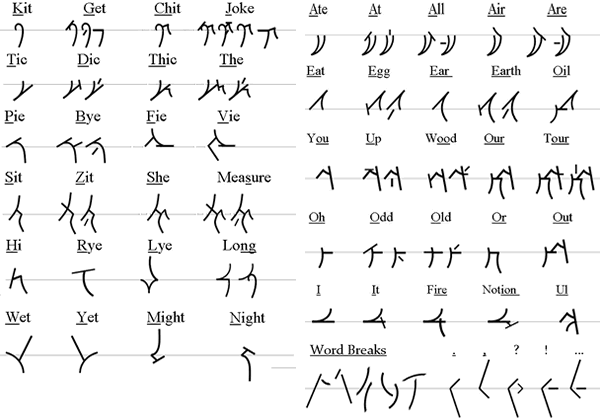
Kummalli is an alternative alphabet for English created by CJ Anderson, who was inspired by this site and the conscripts and alphabets he discovered here. While having created a few, this one he considers to be his pride and joy, and has been working on it in bits and pieces over the last several years. He is also working on using it to create an actual language, but it's a somewhat more ambitious project, that will probably take him the rest of his life ...
Kummalli was constructed with the intent to be somewhat logical, with similar sounding consonants having the same symbols, but with an additional line. For example, "T" and "D" have the symbol, but "D" is differentiated with an additional line on the same symbol. Same goes for "F" and "V", "P" and "B", "S", "Z" "SH" and "ZH", and so on. For such symbols there a couple different ways to write them, some more than that, with the additional line being either attached or not. the creator personally prefers to write them attached, but has illustrated the unattached forms as well. It will also be noticed that while there are no alternate forms of "N" or "R" or "H", but these symbols are altered slightly to combine with others to make sounds like "teeth" or "are". There are also no distinct symbols for "cling" or "bunt", but these could be adapted if the writer so desires.

Almost all symbols within the numbering system can be written up or down, with the exception of the parentheses and brackets, and the plus/minus symbol. The number carrier has 3 positions that are to be filled with the symbols for the numbers themselves. Using the number 27 as an example, the first position would be left blank, and the number 2 would be symbolized in position two, 7 in position 3. The symbols for both exponent and roots also have three positions, with an exponent of two being written with a number 2 in the 3rd position, same with the root symbol, which allows for larger exponents and roots than just squared, or a square root. The variable symbol has six positions, the positions indicated by a dot in one of the intersections. those six positions are likely enough, but the positions can be combined to make more than anyone would probably need. The negative symbol is just the number carrier with an additional line, makes it easier than writing the entire subtraction symbol.


All human beings are born free and equal in dignity and rights. They
are endowed with reason and conscience and should act towards one another
in a spirit of brotherhood.
(Article 1 of the Universal Declaration of Human Rights)
Any questions can be submitted to kummalli1105@gmail.com
Constructed scripts for: Ainu | Arabic | Chinese languages | Dutch | English | Hawaiian | Hungarian | Japanese | Korean | Lingala | Malay & Indonesian | Persian | Tagalog / Filipino | Russian | Sanskrit | Spanish | Taino | Turkish | Vietnamese | Welsh | Other natural languages | Colour-based scripts | Tactile scripts | Phonetic/universal scripts | Constructed scripts for constructed languages | Adaptations of existing alphabets | Fictional alphabets | Magical alphabets | A-Z index | How to submit a constructed script
[top]
You can support this site by Buying Me A Coffee, and if you like what you see on this page, you can use the buttons below to share it with people you know.

If you like this site and find it useful, you can support it by making a donation via PayPal or Patreon, or by contributing in other ways. Omniglot is how I make my living.
Note: all links on this site to Amazon.com, Amazon.co.uk
and Amazon.fr
are affiliate links. This means I earn a commission if you click on any of them and buy something. So by clicking on these links you can help to support this site.
[top]